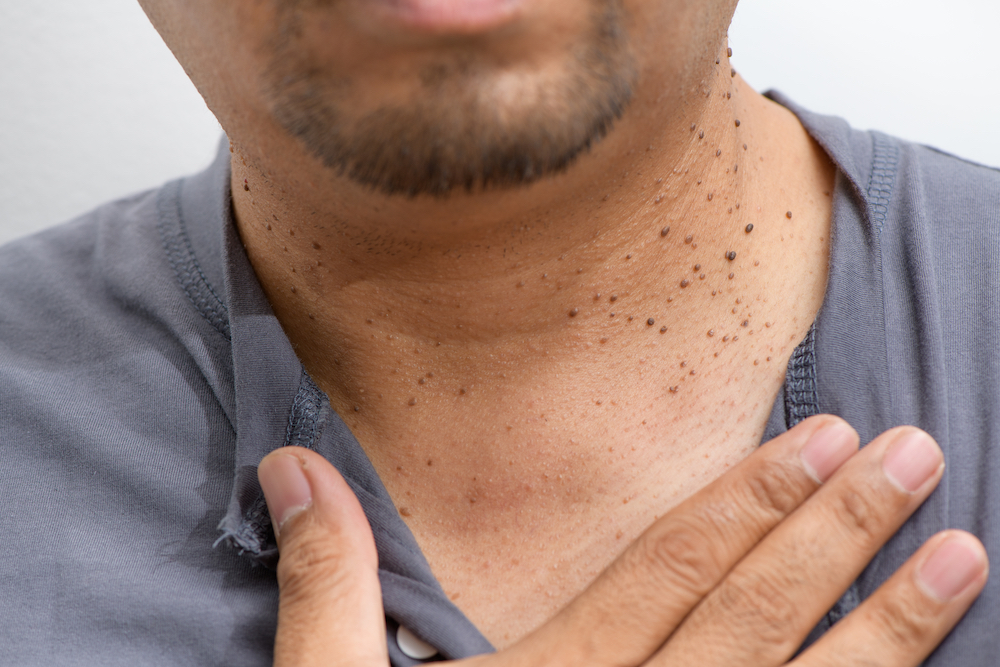Is a Mole the Same as a Skin Tag?

Moles and skin tags are two very common growths that people experience. However, people often get the two confused. They may have a similar appearance and both are typically harmless. But depending on their locations, they can be irritating and unpleasant to look at.
If you have a spot on your skin, especially a new one that has appeared or changed in appearance, you should schedule a visit with your dermatologist. Before you go, it is good to do a little research so you know what to ask your doctor during your visit. Is the growth on your skin a skin tag or a mole? Let’s explore the differences and similarities between the two.
What are moles?
Although most moles are relatively harmless, some can be cause for concern because they can be cancerous. Moles are usually red, pink, light brown or dark brown in color and circular in shape. They’re often slightly raised from the skin but relatively smooth to the touch. Moles are very common. In fact, the prevalence of moles can depend on genetics as well as sun exposure.
Moles are generally nothing to be concerned about, unless you notice the sudden appearance of a new mole or the change in appearance of an existing mole. Atypical moles will vary in appearance and are a reason to schedule an appointment with your dermatologist. Atypical moles may vary in color and shape. Asymmetrical moles and especially those that become raised over time could indicate a potential issue.
The best way to monitor your skin is to get annual skin checks from your dermatologist. During these appointments, your dermatologist will check your skin head to toe to identify any abnormal moles and to track any changes in moles over time. Regular skin screenings are one of the most effective means of preventing skin cancer, including the very dangerous melanoma.
Dermatologists will educate their patients to evaluate their own moles by using a tool called the ABC’s of Melanoma. These five factors could indicate the potential signs of a cancerous mole.
- Asymmetry
- Border
- Color
- Diameter
- Evolving
What are skin tags?
Skin tags typically look like flaps of skin. They generally appear in places where there’s a great deal of friction, such as under the arms, on the neck where a shirt collar rubs against the skin or in the groin area. Over time and with increased friction, the small bump is tugged further from the body, resulting in a hanging piece of skin.
Skin tags can vary in size considerably. Although skin tags are not considered dangerous in any way, they can be irritating and cause some pain. Larger skin tags may be more problematic because they can snag in clothing or be pulled and bleed. Many people find skin tags to be embarrassing, especially those that are in a highly visible location on the body.
Skin tags and moles are not necessarily dangerous but generally will not go away without intervention. Moles in particular should be addressed by a dermatologist to ensure that they are not showing signs of being cancerous.
Anytime you notice a new growth or change in an old mole or spot on your skin, it is best to consult with your dermatologist right away so you can get a proper diagnosis and immediate treatment.
Skin Tags and Moles Atlanta
If you live in the Atlanta area and have an unsightly skin tag or a concerning mole on your body, contact the office of Buckhead Dermatology today. Dr. Straughn has over 25 years of experience treating a wide variety of skin concerns including skin tags, moles and warts. She is highly competent and can provide you with a quick and accurate diagnosis so you can get on the road to treatment and recovery soon.
Contact Buckhead Dermatology of Atlanta today to schedule an appointment at either of our Atlanta or College Park offices.
